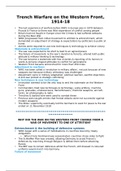1
Trench Warfare on the Western Front,
1914-18
• The last experience of warfare before WW1 in Europe was in 1870 between
Prussia & France so there was little experience of confict among people
• Britain had not fought in Europe since the Crimea & had sufered setbacks
during the Boer War
• WW1 progressed from initial movement to attrition & entrenchment, which
demanded an adjustment of strategy & expectations by politicians & public at
home
• Armies were required to use new techniques & technology to achieve victory
Stalemate & entrenchment
• The war was expected to be short & lead to an agreed peace
• The failure of movement, & the war’s duration & ferocity, altered both public
attitude & military thinking & technology
• The war became a stalemate with few victories & reporting of its horrors in
words & pictures shaped attitudes to confict for generations
• Western Front became entrenched for more than 450 miles
Adjustment & reactions
• WW1 has been called a ‘revolution in military afairs’, not just because of new
weapons but because military orthodoxy was challenged
• Adjustment came in military adaptation, political reaction, pacifst objections
& anti-war protest & strategic rethinking
New techniques & new technology
• Innovation seemed to be the only way to end the stalemate on the Western
Front
• Commanders tried new techniques & technology, using artillery, machine
guns, grenades, smokescreens, famethrowers, chemical weapons, aircraft,
tanks, air photography & radio
• Trenches & barbed wire were used to combat these
• Previous wars taught armies that frontal attacks were not successful against
modern weapons
• The Allies’ superiority eventually led the Germans to seek for peace & the war
ended on 11 November 1918
============================================
============
WHY DID THE WAR ON THE WESTERN FRONT CHANGE FROM A
WAR OF MOVEMENT TO ONE OF ATTRITION?
Entrenchment & the building of defensive systems
• WW1 began with a series of mobilisations in countries bound by treaty
obligations
‣ When Franz Ferdinand was assassinated, countries chose sides to fght
• The Schliefen Plan was created, allowing Germany to avoid France’s
defences by marching through Belgium & defeat them before attacking
Russia
• The BEF was to remain defensive whilst the French, still dressed in coloured
uniforms would march into Germany
Failure of movement





